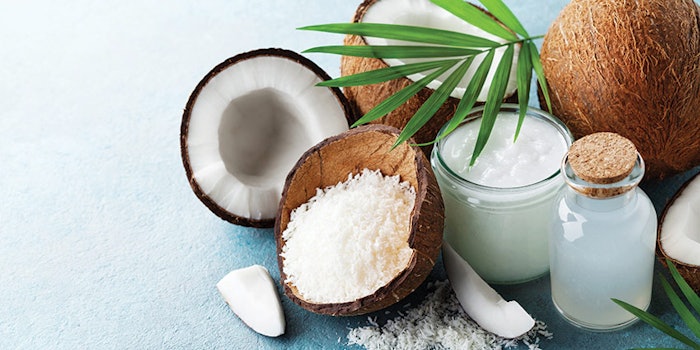
Read this article in its entirety in the July/August 2020 digital edition. . .
The use of bio-based surfactants is associated with a wide range of sectors including laundry detergents, foods, cosmetics, personal care products, etc. Taurates, which are bio-based ionic surfactants, have gained considerable interest in hair care, baby and oral care industry. They are the only class of anionic surfactants that combine the advantages of strong detergency with: no loss of performance in hard water; stability to hydrolysis in acid or alkaline medium; soap-like mildness to skin; and easy biodegradability.1
Sodium methyl cocoyl taurate (SMCT), derived from coconut and a salt of coconut fatty acid amide of N-methyltaurine, is the most commonly used taurate by formulators looking for high-foaming, mild surfactants for baby or adult skin and hair care products.1-4
Chemistry and Manufacture
Chemical structure: SMCT has a hydrophilic head group consisting of N-methyltaurine (2-methylaminoethanesulfonic acid) and a lipophilic group consisting of a long-chain coconut fatty acid, both linked via an amide bond. SMCT is an anionic surfactant with a strong electronic sulfo-negative group and a mild cationic amine group (see Figure 1).
Manufacture: The manufacture of SMCT starts with sodium isethionate, which is produced by reacting ethylene oxide and sodium bisulfite. Minor changes in the manufacturing process yield products of various physical states—e.g., clear liquid, slurry, paste, gel or powder, which differ only in their concentration of active ingredient, pH and percentage of water and inorganic salts.
The first step toward producing SMCT is to produce the pre-cursor, N-methyl taurine, a critical intermediate, by reacting sodium isethionate with methylamine (see Figure 2).
From this precursor, there are two synthesis routes to make SMCT.1, 5-7 The two routes produce SMCT with differences in their levels of free fatty acids and NaCl, form and actives levels (see Table 1).
First route: The first route of synthesis is the amidation of coconut acid with methyl taurine, which results in a low-NaCl SMCT with a high free fatty acid level (SMCT:FFA Ratio ~7 w/w; see Figure 3).7
. . .Read more in the July/August 2020 digital edition. . .
References
- Petter, P.J. (1984). Fatty acid sulphoalkyl amides and esters as cosmetic surfactants. Intl J Cos Sci. 249-260. https://onlinelibrary.wiley.com/doi/abs/10.1111/j.1467-2494.1984.tb00382.x
- Farn, R.J., ed. (2006, Mar 6). Chemistry and Technology of Surfactants. Blackwell Publishing. https://onlinelibrary.wiley.com/doi/book/10.1002/9780470988596
- Cosmetic Business (2007, Apr 11). Acylated amino acids: Multifunctional surfactants for new applications. https://www.cosmeticsbusiness.com/news/article_page/Acylated_amino_acids_Multifunctional_surfactants_for_new_applications/47674
- Iwata, H. and Shimada, K. (2012). Formulas, Ingredients and Production of Cosmetics, Technology of Skin- and Hair-Care Products in Japan. Springer. https://www.springer.com/gp/book/9784431540601
- CIR (2015, Jun 1). Safety assessment of alkyl taurate amides and taurate salts as used in cosmetics. https://www.cir-safety.org/supplementaldoc/safety-assessment-alkyl-taurate-amides-and-taurate-salts-used-cosmetics-0
- Burnette, L.W., and Chiddix, M.E. (1962, Nov 1). Reaction of fatty acids with N-methyl taurine. J Amer Oil Chem Soc. https://aocs.onlinelibrary.wiley.com/doi/abs/10.1007/BF02637229
- Day, J.F. (1994, May 23). US5496959A. Preparation of N-acyl taurates. https://patents.google.com/patent/US5496959A/ en











